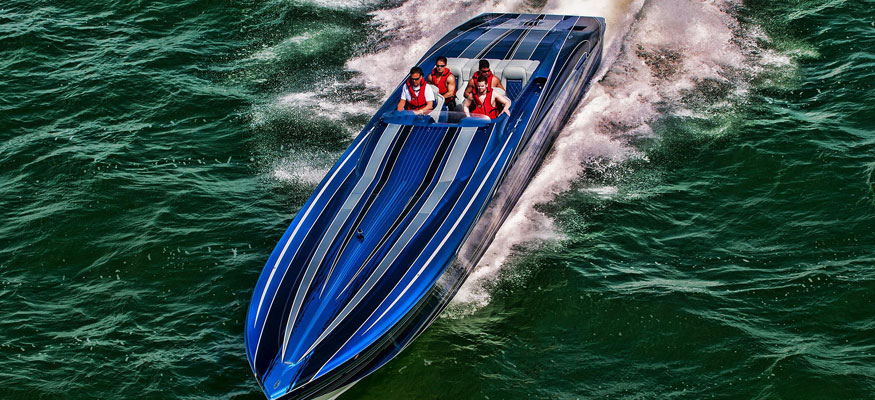Tres Martin’s Safety Corner: Vested Interest
Whether he’s teaching a driving course, testing a boat he’s rigged for a client or builder, giving a demo ride to a would-be buyer or just chilling on a weekend with his family, if Performance Boat School founder Tres Martin is on the water he’s wearing his Lifeline Sport jacket. That’s right, the former offshore racing world champion and noted driving instructor does not get into a boat unless he’s wearing his preferred personal flotation device.
And we’re not talking about inflatable suspenders, a rubber personal watercraft vest or one of those United States Coast Guard-approved orange “Mae West” vests you are required to have on your boat for every passenger. We’re talking about a Lifeline sport jacket with substantial padding inside beefy nylon and a neck collar for protection during impact, as well as legs straps that will help keep the jacket on your body in the event you’re ejected at high-speed.
“I never get out on the water without my Lifeline jacket because it has the best ability to save my life,” says Martin. “I am looking for every advantage I can find to stay alive. It has the most coverage of any jacket and it can do something, meaning roll me on my back so I can breathe, if I’m unconscious in the water.”
Martin’s hard and fast rule about wearing jackets while underway extends to everyone on his boat. All of his children have their own Lifeline Sport jackets (“The small size fits them,” he says) and taking them off when the boat is running is not an option. Same goes for Martin’s guests.
“A couple of years ago I had a client who was trying to sell a boat,” he says. “They sent down a surveyor, and part of the survey included a sea trial. The top speed of the boat was only about 55 mph. I put on my jacket and handed one to the surveyor. He said, ‘I don’t need this.’ I said, ‘Then you don’t need to go for a boat ride.’
“There are no exceptions,” he adds. “And if I’m on someone else’s boat and no one is wearing a jacket, I’ll still wear mine. I don’t care if there are five people on board and I’m the only person wearing one.”
While Martin says a personal watercraft vest, which is typically made of neoprene, is “better than nothing,” it is no replacement for a properly designed and constructed sport jacket.
“I’m not sure they could provide much protection in an impact with the water at high-speed, and generally they don’t have the ability to roll your on your back so you can breathe if your unconscious,” he explains. “The other thing is, if you hit the water at just the wrong angle they can be pulled off over your head and tear the ligaments in your arms. Then you have only yours legs to help keep you swim and stay afloat. And plus, on a hot day, all the neoprene is not going to be comfortable.”
Even less useful and appropriate for use in high-performance powerboat are the auto/manual inflating “suspender” style PFDs. Without question, the light, harness-style vests are the most “comfortable” on a hot day, yet for that very reason they offer the least amount of protection in event you are ejected from a boat at high-speed. And there’s a good chance they’ll be torn from your body if you hit the water with substantial velocity.
“We completely discourage using those in our school,” says Martin. “If I recall, the two people who died in 2004 during the Smoke on the Water Poker Run were wearing that style of vest. They found the vests inflated and floating on there on their own. People like them because they’re comfortable and fulfill the ‘requirement’ of some poker runs and events. But they’re not appropriate for use in high-performance powerboats.
“You can be a great boat driver with the best equipment, but at the end of the day anything can happen,” he adds. “You can be ejected from the boat. That’s when you’re going to need your life-saving device, and when it comes to these devices you don’t get another chance once the incident has taken place. If you’re not wearing the right jacket and lights go out, the lights go out forever.”
According to U.S. Coast figures, the cause of death in 80 percent of boating accidents is drowning, and of those who die that way every year roughly 70 percent are not wearing PFDs. So while the expression, “It won’t work if you don’t wear it” may seem a little trite, it’s the truth. Martin says that needs to happen not only every time someone gets on your boat, but also when dealer, brokers and builders take customers for their very first rides.
“We are the industry—we have to set the standard and send the right message from the start,” he says. “When I go boating and I see you and your passengers wearing jacket, I’m really happy. It means you care and that everything is important to you. You want to wear them so regularly that it becomes second nature to put on your jacket. You’d feel like you were missing something if you didn’t put it on, because you would be.”
Related Story
(Photo courtesy/copyright Jay Nichols/Naples Image.)


